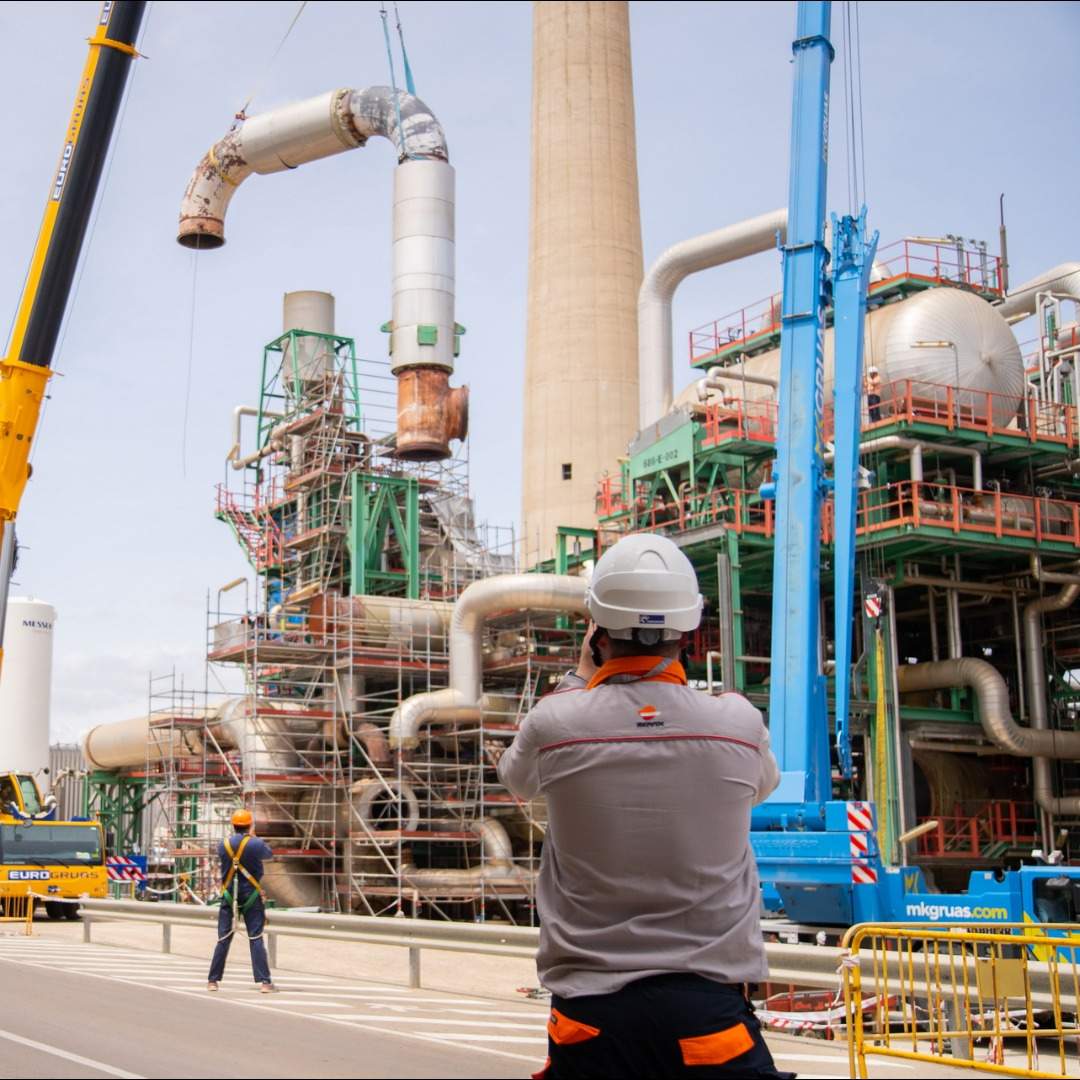
CO2 capture technologies
CO2 capture technologies
Capturing and storing CO2: the key technology to decarbonize industry
Capturing and storing CO2: the key technology to decarbonize industry
Cement, steel, aluminum, fuels, or chemical derivatives are essential products for our society. However, their production causes carbon dioxide emissions (CO2)(1) that are difficult to reduce. In order to decarbonize these industries, the most effective solution is to resort to CO2 capture and storage technologies (CCS), an already mature alternative that will be key in the coming decades.
CCS technologies allow the CO2 emitted in industrial processes to be trapped before reaching the atmosphere, to then store this gas safely in underground geological formations. Both the United Nations and the International Energy Agency (IEA) recognize the crucial role that it will have in the fight against global warming. The IEA estimates that, in order to achieve climate neutrality by 2050, 1,000 Mt/year of CO2 will need to be captured and stored globally by 2030 and 6,000 Mt/year by 2050, although for that it will be necessary to pick up the pace of implementation of current projects.
Within the set of CO2 emissions are the so-called 'hard-to-abate'. These originate in energy-intensive industries, where electrification isn't an alternative to meet their energy needs, such as basic petrochemicals, or in sectors where the emission of CO2 is attached to their processes, such as that of cement.
What is the contribution of these energy-intensive sectors to the planet's emissions? Cement production generates 8% of global CO2 emissions, while steel produces 7%, above air and maritime transport, which is situated at around 2-3%. In the case of cement, an essential component to make concrete, the Global Cement and Concrete Association (GCCA) estimates that the use of CCS technologies will allow its emissions to be reduced by 36%. For its part, steel is a basic material for other activities such as the automotive industry, which is the main exporter in the UE economy and represents 6% of its direct and indirect jobs.
CCS technologies are essential to decarbonize the cement, steel, and chemicals industries, whose emissions are very difficult to reduce by other means
On the other hand, the manufacturing industry contributes 20% to the total global emissions. In this sector, basic petrochemicals, which obtain chemical derivatives from oil and its associated gases, will need a high reduction of their emissions. Around a 20% reduction can be achieved through energy efficiency and electrification and, for the remaining 80%, the geological capture and storage of CO2 is the solution with the highest level of technological development, according to a study from the engineering company Technip Energies.
"CCS technologies are an essential decarbonization option to reduce CO2 emissions in many energy-intensive industrial sectors, such as steel, cement, or chemicals, among others, allowing progress towards net zero emissions in an efficient and competitive manner," Marta González explains, CCS Commercial & Marketing Manager at Repsol.

A technology with a high degree of maturity
A technology with a high degree of maturity
Today, 50 CO2 capture and storage facilities are already operating around the world, 44 are under construction, and over 500 are in development phase, according to data from the Global Carbon Capture and Storage Institute. This body gives the readiness level of these technologies (TRL) a 9, the highest value in this international measurement standard.
Norway has been the pioneer country in Europe in the deployment of these technologies. The Sleipner CCS facility has been operating since 1996 and in this saline formation, located in the North Sea, 240 km off the Norwegian coast, over 20 Mt of CO2 has already been stored. "This project is an example of transparency because it has published its data in real time, which has allowed researchers from around the world to understand the flow processes, make more precise predictions, and develop methods for the safe storage of CO2," Marta González explains.
The Sleipner CCS facility, located 240 kilometers off the Norwegian coast, has been operating since 1996 and over 20 Mt of CO2 has already been injected there
Norway has been the pioneer country in Europe in the deployment of these technologies. The Sleipner CCS facility has been operating since 1996 and in this saline formation, located in the North Sea, 240 km off the Norwegian coast, over 20 Mt of CO2 has already been stored. "This project is an example of transparency because it has published its data in real time, which has allowed researchers from around the world to understand the flow processes, make more precise predictions, and develop methods for the safe storage of CO2," Marta González explains.
The Northern Lights project, also in Norway, is also noteworthy, because it has signed the first commercial agreement in the world for the cross-border transportation and storage of CO2 with the company Yara International, which from 2025 will send to this facility for its storage the gas captured in its fertilizer and ammonia production plants in the Netherlands. International collaboration will be essential and "this agreement opens the possibility to offer transportation and storage as a service. There will be companies that don't have sites for geological storage or not in the sufficient amount and some flows of CO2 towards others where there is will be required," the Repsol expert highlights.
Captured CO2 can be safely stored in geological formations located at a depth of between 1.5 and 2 km within the subsoil
Porthos, in the Netherlands, is the first large-scale project in the EU. The CO2 generated by industries located in the Rotterdam port environment will be transported through a tube of over 30 kilometers to the North Sea, where it will be stored in depleted gas fields, at over 3 kilometers in depth. With some storage estimates of 37 million tonnes of CO2, with around 2.5 Mt of CO2 per year over 15 years, its strategic value has earned it recognition as a Project of Common Interest, therefore receiving European funding.

A pending subject in Spain
A pending subject in Spain
In Spain, the Spanish CO2 Technology Platform (PTECO2), a think tank that groups together companies involved in the CO2 chain, public institutions, and R+D centers, indicates in its 2024 report "CCUS technologies, a country opportunity" that, despite the energy efficiency improvement or the use of hydrogen and renewable fuels in processes, two thirds of the country's industrial emissions are hard-to-abate, so it considers that these technologies will be an essential option to decarbonize the industrial fabric.
The Spanish government has recently included recognition of the use of this solution in the National Integrated Energy and Climate Plan (PNIEC), although limited to those sectors where there are no better abatement alternatives. For the PTECO2, in Spain "we are late. The main countries in the eurozone have a well-defined strategy and specific projects under development with public support. But with State support and a roadmap, it can be achieved."
"Spain has great potential, with universities and research centers with extensive experience in the knowledge of CCUS technologies. However, the degree of action at the industrial level is still low," Fèlix Llovell explains, director of the Repsol Foundation Energy Transition Education and Research Program on CO2 capture and use at the Universidad Rovira i Virgili. A new industry could also emerge around these technologies, with whose development the PTECO2 estimates 70,000 jobs could be created and over 7 billion euros of added value for the economy mobilized. "Although it is evident that the adoption of these technologies will represent a significant initial cost, there is a long-term return from which the whole society will benefit."
(1)Some gases from the earth atmosphere act by retaining the sun's heat and prevent it escaping to space, thus causing global warming. Many of these greenhouse gases are produced naturally, but, due to human activities, the concentrations of some of them are increasing in the atmosphere, especially those of carbon dioxide (CO2), methane, nitrous oxide, and fluorinated gases, being harmful for the environment.


